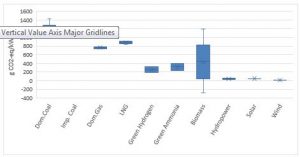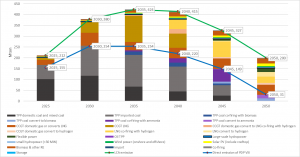A Life Cycle Assessment (LCA) is a methodology to assess the environmental impacts of a product or service through all processes, from cradle-to-grave – including raw material extraction, manufacture and use, to end-of-life disposal. When analyzing the global warming impact of energy systems on LCA basis, greenhouse gas (GHG) emissions (particularly CO2, CH4, and N2O) are of primary concern.
Currently the Power development plan in period 2021 – 2030 with vision to 2050 (PDP VIII) accounted for direct emission of mainly coal and gas power. The expert’s group of IEVN carried out the LCA emissions study for types of power generation in Vietnam power system, and based on the results the LCA CO2-eq emissions for the power source development program according to Power Plan VIII is calculated to better understand the full emissions impact of different energy options across the entire energy supply chain, including upstream and downstream emissions.
This study carried out LCA of GHG emission for Vietnam power sector refer to IPCC guidelines focus on 10 types of power sources including 5 thermal power (domestic coal, imported coal, domestic gas, LNG, green hydrogen and green ammonia) and 5 renewable powers (biomass, waste power, hydro, solar and wind).
In the study, “cradle to grave” method has been used, which the emission of power source is account for upstream, direct emission and downstream. The upstream emission includes: (i) one-time upstream (mainly construction of power plants, producing of solar PV/wind turbine) and (ii) ongoing upstream depend on power source (from coal mining/gas extraction/green H2/NH3 production, transportation…in thermal power to cultivation, processing, transportation, electricity & materials for auxiliary services in renewable power. Especially this study has account for “forgone sequestration” and “carbon sequestration” for biomass power. The direct emission is in the process of power generation and downstream emission mainly on dismantle of power plants.
Summary of calculation result of CO2-eq emission on the life cycle basis of different types of power sources in Vietnam in the GWP-20 year are as follow:
 Figure 1: Comparison of CO2-eq emission on the LCA basis of different types of power sources in Vietnam power system (GWP-20 year)
Figure 1: Comparison of CO2-eq emission on the LCA basis of different types of power sources in Vietnam power system (GWP-20 year)
Calculations for reference of LCA emission for Vietnam’s power development program according to Power Plan VIII (base scenario) show that emissions based on LCA will have emissions CO2 equivalent is 1.7 times higher in 2035 and 6.5 times higher in 2050. This is due to the increased share of renewable energy and green hydrogen/ammonia energy sources and zero direct emissions from these sources , but in LCA calculations they have significantly equivalent CO2 emissions.
 Figure 2: Comparison of LCA emission and direct emission in PDP VIII – base demand
Figure 2: Comparison of LCA emission and direct emission in PDP VIII – base demand
For downloading the full report, please contact:
MSc. Nguyen Van Duong – Researcher at Power system development department – Institute of Energy
Email adress: nvduong.ie.vn@gmail.com.




